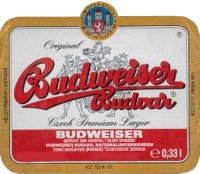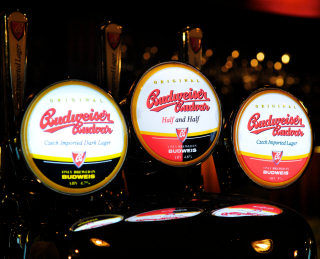 |

|
|

|
|
|
 |

home
about
features
A-Z
books

|

|

features
|

| |
Budvar - Lager as it should be
by Willard Clarke, 01/11
What does the word "lager" mean to you? A cold, bland, fizzy drink knocked out in vast volumes by global brewers - or a beer full of both flavour and history?
In recent years a major divide has opened up between global brewers and smaller independents. The German word lager means "storage place", similar to the English word larder. Once,
all lager beers were stored for several months while they underwent a second fermentation at a temperature just above freezing point.
But now most major lager brands are produced as quickly as ale. When the late Michael Jackson visited the Coors brewery in Burton-on-Trent to record a piece for BBC Radio, he was
astonished to find that Carling is produced in just a few days and he queried whether it deserved to be branded as lager. I have similarly found at both Carlsberg's Baltika breweries in
Russia and Heineken's Zywiec brewery in Poland that the entire brewing regime - from mashing to keg-filling - lasts just 21 days. It's the same with the world's biggest beer brand,
American Budweiser - though 21 days can be reduced at periods of high demand.
 If you compare these industrial lagers with the true lagers still brewed in the Czech Republic, Germany and the Netherlands, a great chasm opens up between the tasteless and the tasty.
For example, the classic Czech golden lager Budweiser Budvar (5%) is lagered or cold conditioned for 90 days. Some Bock beers - strong lagers - are conditioned for even longer. For example,
the world-famous Samichlaus (14%), brewed by Eggenberg in Austria, is matured for between nine and 10 months. The equally famous German Bock, EKU 28 (13.5%), is also matured for nine
months while Paulaner Salvator Doppelbock (7.5%), originator of the Munich Bock style, enjoys three months in the lager cellar.
On a number of occasions I have sat in the celebrated Englischer Garten in Munich, seen wooden casks of Helles or pale lager delivered by a local brewery and then served by its own natural carbonation and wondered whether all true lagers were once dispensed in this manner. Munich beers are rarely exported but we can now get a fascinating glimpse of "real lager" thanks to the arrival in the London area of Budvar "yeast beer". This is a version of the 5% Budvar original that is neither filtered nor pasteurised and which is cold conditioned for 100 days in the cellars beneath the brewery in Ceske Budejovice.
In discussions with Josef Tolar, the retired brewmaster at Budvar, I discovered that this was the typical version of Budvar for several decades after the company's founding in 1895. Budvar
didn't install a pasteurising unit until 1937 and that was used mainly for bottled beer for export. Draught beer for home consumption wasn't pasteurised and that is still the case in the
Czech Republic in bars with a fast turnover of beer, where air pressure is the preferred method of dispense.
Similarly, until the craze for crystal-clear beer put pressure on smaller brewers, Budvar saw no need to filter its beer as yeast and protein settle at the base of conditioning tanks during
the long lagering process.
If you compare these industrial lagers with the true lagers still brewed in the Czech Republic, Germany and the Netherlands, a great chasm opens up between the tasteless and the tasty.
For example, the classic Czech golden lager Budweiser Budvar (5%) is lagered or cold conditioned for 90 days. Some Bock beers - strong lagers - are conditioned for even longer. For example,
the world-famous Samichlaus (14%), brewed by Eggenberg in Austria, is matured for between nine and 10 months. The equally famous German Bock, EKU 28 (13.5%), is also matured for nine
months while Paulaner Salvator Doppelbock (7.5%), originator of the Munich Bock style, enjoys three months in the lager cellar.
On a number of occasions I have sat in the celebrated Englischer Garten in Munich, seen wooden casks of Helles or pale lager delivered by a local brewery and then served by its own natural carbonation and wondered whether all true lagers were once dispensed in this manner. Munich beers are rarely exported but we can now get a fascinating glimpse of "real lager" thanks to the arrival in the London area of Budvar "yeast beer". This is a version of the 5% Budvar original that is neither filtered nor pasteurised and which is cold conditioned for 100 days in the cellars beneath the brewery in Ceske Budejovice.
In discussions with Josef Tolar, the retired brewmaster at Budvar, I discovered that this was the typical version of Budvar for several decades after the company's founding in 1895. Budvar
didn't install a pasteurising unit until 1937 and that was used mainly for bottled beer for export. Draught beer for home consumption wasn't pasteurised and that is still the case in the
Czech Republic in bars with a fast turnover of beer, where air pressure is the preferred method of dispense.
Similarly, until the craze for crystal-clear beer put pressure on smaller brewers, Budvar saw no need to filter its beer as yeast and protein settle at the base of conditioning tanks during
the long lagering process.
 In order to encourage a second fermentation in the cellar, Josef Tolar explains that a small proportion of sugar-rich unfermented wort - the result of the mashing process - is blended with
beer in the lager tanks. This method is known in German as kr�usening and Mr Tolar prefers to call this version of Budvar "kr�usen beer" rather than yeast beer.
The finished beer
has only the slightest hint of haze as it "drops bright" naturally in the lager tanks. The typical Budvar aroma and flavour of toasted malt, a hint of vanilla and
floral Saaz hops are overlain by a gentle estery/yeasty note. The version on sale in London is served by nitrogen and C02, but volumes are low and the beer in the glass is free from gas bubbles.
Budvar yeast beer has a shelf life of 28 days and is brewed three or four times a year. It's currently available in all three branches of the Draft House in Battersea, Clapham and
Tower Bridge Road, along with the Porter House in Covent Garden and the White Horse at Parson's Green.
In order to encourage a second fermentation in the cellar, Josef Tolar explains that a small proportion of sugar-rich unfermented wort - the result of the mashing process - is blended with
beer in the lager tanks. This method is known in German as kr�usening and Mr Tolar prefers to call this version of Budvar "kr�usen beer" rather than yeast beer.
The finished beer
has only the slightest hint of haze as it "drops bright" naturally in the lager tanks. The typical Budvar aroma and flavour of toasted malt, a hint of vanilla and
floral Saaz hops are overlain by a gentle estery/yeasty note. The version on sale in London is served by nitrogen and C02, but volumes are low and the beer in the glass is free from gas bubbles.
Budvar yeast beer has a shelf life of 28 days and is brewed three or four times a year. It's currently available in all three branches of the Draft House in Battersea, Clapham and
Tower Bridge Road, along with the Porter House in Covent Garden and the White Horse at Parson's Green.
|
|
home
about
features
A-Z
books
|

